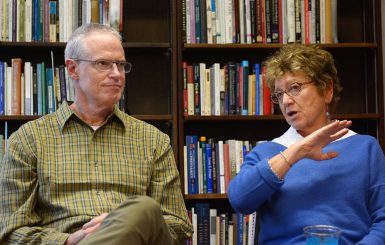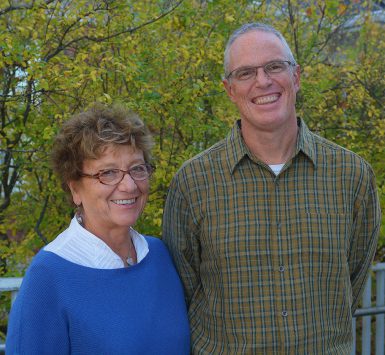Filmmakers look at young journalists covering tragedy, diversity

Filmmakers Meg Moritz and Jeff Browne of the University of Colorado Boulder showed their latest documentary, Taking the Lede, and Moritz’ earlier film, Covering Columbine, during a visit to campus in October.
The two conducted question-and-answer sessions after the screenings in Ernie Pyle Hall.
The two films share a connection. After the release of Covering Columbine, which documents the lives of students, parents and journalists after the 1999 Columbine High School shootings, Moritz said she began hearing from high school journalists about covering tragedies, sometimes at their own schools.
Thinking about that scenario, Moritz and Browne began work on Taking the Lede, which explores how high school journalist handle real-life issues – from shootings to gay rights – that affect all students.
“It’s an explanatory documentary about the work and the importance of the work student journalists do,” Moritz said in an interview.
The pair met while teaching at the university. Moritz, whose research focuses on journalists’ ethical practices in the field, said she was particularly interested in how high school students covered crisis as a follow-up to Covering Columbine.
A conversation with Jeff Brown and Meg Moritz, Producers of “Taking the Lede” A documentary about high school journalists
Jeff Brown and Meg Moritz, producers of “Taking the Lede”
The two sit in front of a bookshelf across from the interviewer.
The initial idea was to look at crisis reporting, reporting on traumas, and there certainly was material to do that. Crisis reporting in high schools where the students are the journalists and the students are the victims of the crimes and that kind of thing. I mean, they’re still students or former students. Yep, and and you know, there’s plenty of material to have a lengthy in-depth piece, documentary, magazine, book, whatever, on that topic, but a couple of things happened. One was I felt that it would be so grim or could be so grim to have that, and Jeff had been telling me story after story that had other aspects that were interesting, also had humor involved and censorship issues involved, and so we just, as we talked, we just thought we could expand this out and do a section on crisis reporting. Yeah, yeah, so, so we wound up with I think four, four or five depending upon how you count, case studies of things that students encounter in their journalistic careers in high school.
Produced by Nina Murov
Browne was involved in student media both in colleges and high schools in the Colorado area during his 25 years of teaching and advising. He currently is director of CU News Corps at the College of Media, Communication and Information at the university in Boulder. The News Corps team helped in the filming and interviewing process.
The two said their experiences complemented one another for the project.
“I knew nothing about high school journalism,” Moritz said.
“And I knew nothing about filmmaking,” Browne said.
The duo worked and produced the film earlier this year and edited over the summer. Already, they have entered Taking the Lede in the Boulder International Film Festival and Big Sky Film Festival in Montana, which is exclusively for documentary films.

Moritz and Browne wanted the documentary to serve as an overlay of issues student journalists face. They used three case studies of high school journalists tackling complex issues.
Investigative journalism was one. They presented the case of J. David McSwane, who as a high school journalist in 2005 went undercover to uncover the truth about army recruitment practices. The investigative report won a Peabody Award.
Browne had been McSwane’s advisor, so getting his story was a no-brainer for the pair.
At a different high school, a team of yearbook editors was left with the task of covering the story of a shooting that took place within their own hallways. One of the editors, Joe Redmond, was a close friend of the shooter. He wrote an award-winning essay, “On Forgiveness,” which Moritz found to be “very poignant.”
The Lever, the oldest high school student-run newspaper in Colorado, was also faced with adversity. Moritz and Browne found two cases, one in 1996 and one in 2012, that illustrated censorship of LGBT acknowledgement at student papers.
The school is located in Colorado Springs, which Browne frames as more conservative than other cities in the state. In the 2012 case, the school board broke Colorado law in not letting students publish a picture of a lesbian couple holding hands.
The law protecting those student journalists from censorship is called the Anti-Hazelwood law, and it is named for the 1988 U.S. Supreme Court ruling of Hazelwood School District v. Kuhlmeier, which restricted high school journalists First Amendment Rights. Its adoption varies by state. Indiana does not have an Anti-Hazelwood law.
While on campus, Moritz had lunch with Hutton Honors and Media School students and attended a reception at the Poynter Center for the Study of Ethics and American Institutions. After the visit to IU, Moritz attended the Indiana High School Press Association convention at Franklin College.
The visit was sponsored by GBLT Support Services, Center for Documentary Research and Practice, IU Journalism, the Poynter Center for the Study of Ethics and American Institutions, and Hutton Honors College.

